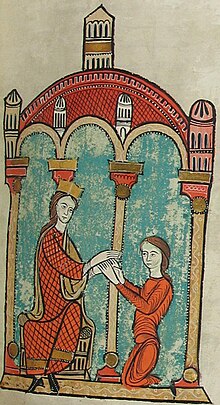Ramon Berenguer IV, Count of Barcelona
| Ramon Berenguer IV | |
|---|---|
| Count of Barcelona | |

Ramon Berenguer IV in the Liber feudorum maior
|
|
| Count of Barcelona | |
| Reign | 19 August 1131 – 6 August 1162 |
| Predecessor | Ramon Berenguer III |
| Successor | Alfonso I |
| Spouse(s) | Petronilla of Aragon |
| Issue | |
| Noble family | Barcelona |
| Father | Ramon Berenguer III, Count of Barcelona |
| Mother | Douce I, Countess of Provence |
| Born |
c. 1114 Rodez |
| Died | 6 August 1162 (aged 48–49) Borgo San Dalmazzo, Piedmont, Italy |
| Buried | Santa Maria de Ripoll |
| Signature |  |
| Religion | Roman Catholic |
Ramon Berenguer IV (Catalan pronunciation: [rəˈmom bəɾəŋˈɡe]; c. 1114 – 6 August 1162, Anglicized Raymond Berengar IV), sometimes called the Saint, was the Count of Barcelona who brought about the union of his County of Barcelona with the Kingdom of Aragon to form the Crown of Aragon.
Ramon Berenguer IV inherited the county of Barcelona from his father Ramon Berenguer III on 19 August 1131. On 11 August 1137, at the age of about 24, he was betrothed to the infant Petronilla of Aragon, aged one at the time. Petronilla's father, Ramiro II of Aragon, who sought Barcelona's aid against Alfonso VII of Castile, withdrew from public life on 13 November 1137, leaving his kingdom to Petronilla and Ramon Berenguer, the latter in effect becoming ruler of Aragon, although he was never king himself, instead commonly using the titles "Count of the Barcelonans and Prince of the Aragonians" (Comes Barcinonensis et Princeps Aragonensis), and occasionally those of "Marquis of Lleida and Tortosa" (after conquering these cities). He was the last Catalan ruler to use "Count" as his primary title; starting with his son Alfonso II of Aragon the counts of Barcelona styled themselves, in the first place, as kings of Aragon.
The treaty between Ramon Berenguer and his father-in-law, Ramiro II, stipulated that their descendants would rule jointly over both realms, and that even if Petronilla died before the marriage could be consummated, Berenguer's heirs would still inherit the Kingdom of Aragon. Both realms would preserve their laws, institutions and autonomy, remaining legally distinct but federated in a dynastic union under one ruling House. Historians consider this arrangement the political masterstroke of the Hispanic Middle Ages. Both realms gained greater strength and security and Aragon got its much needed outlet to the sea. On the other hand, formation of a new political entity in the north-east at the time when Portugal seceded from León in the west gave more balance to the Christian kingdoms of the peninsula. Ramon Berenguer successfully pulled Aragon out of its pledged submission to Castile, aided no doubt by his sister Berengaria, wife of Alfonso the Emperor, who was well known in her time for her beauty and charm.
...
Wikipedia
